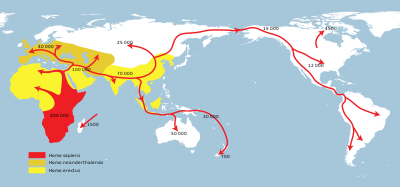早期人類遷徙

█ 智人 █ 尼安德特人 █ 直立人

早期人類遷徙是指人屬物種各個祖先群體,離開原有棲息地非洲,往其他陸地遷徙,最後除南極洲以外,在全球各地聚居的過程。是基于現存的化石、文物、遺跡、DNA、以及語言(用於存活物種智人)做出的推論[1]。
直立人
直立人約在180萬年前[2],通過黎凡特走廊,遷住歐亞大陸[3]。在2017年研究證據使科學家提出的證據提出了新的可能,意識到早在12萬年前,早期的一批智人可能已經到達亞洲,並與直立人留下共同混合基因[4][5]
前人
前人[a]約於80萬年前、海德堡人約於60萬年前離開非洲[7],他們再演化成尼安德特人[7],在2017年提出的證據提出即在27萬年前,更早一批的智人遷移中可能留下尼安德特人基因組中的混合物[8] [9]。
智人
智人(現代人類)于20萬年前左右在非洲大致演化完成[10],後來亦展開了遷徙旅程。
粒線體DNA分析
據人類粒線體DNA單倍體群的分析研究,約於13萬至9萬年前[11],一支粒線體單倍群 L3 智人離開了非洲,可能是從東非由陸路經西奈半島入黎凡特,或由海路從非洲之角越過紅海到達阿拉伯半島南方,擴遷至西亞棲息[12][13]。粒線體單倍群 L3 在東非、阿拉伯半島棲息多年後,其後裔粒線體單倍群 M 與粒線體單倍群 N 從西亞往南亞遷徙,粒線體單倍群 M 約在7萬年前演化成粒線體單倍群 M2,與其他粒線體單倍群 M 的後裔,粒線體單倍群 M3、M4'30、M5、M6、M25、以及這些單倍群的演化群,定居在印度次大陸[14];粒線體單倍群 M 在5萬年前演化成粒線體單倍群 M31 與 M32,他們渡海定居在安達曼群島[15]。
注释
参见
參考資料
- ^ Erin Wayman. How to Retrace Early Human Migrations. Smithsonian.com. 2012-09-26 [2014-10-22] (英语).
- ^ Homo erectus. Palomar College. [2014-10-22] (英语).
- ^ Homo Erectus, out of Africa Theory. Facts And Details. [2014-10-22] (英语).
- ^ Kuo, Lily (10 December 2017)."Early humans migrated out of Africa much earlier than we thought". Quartz. Retrieved 10 December 2017.
- ^ Kuo, Lily (10 December 2017)."Early humans migrated out of Africa much earlier than we thought". Quartz. Retrieved 10 December 2017.
- ^ Homo antecessor. nature culture discovery. Australian Museum. [2014-10-22]. (原始内容存档于2014-11-04) (英语).
- ^ 7.0 7.1 Homo heidelbergensis. nature culture discovery. Australian Museum. [2014-10-22]. (原始内容存档于2014-11-04) (英语).
- ^ Zimmer, Carl (4 July 2017). "In Neanderthal DNA, Signs of a Mysterious Human Migration". New York Times. Retrieved 4 July 2017.
- ^ Posth, Cosimo; et al. (4 July 2017)."Deeply divergent archaic mitochondrial genome provides lower time boundary for African gene flow into Neanderthals". Nature Communications.doi:10.1038/ncomms16046. Retrieved4 July 2017.
- ^ Homo sapiens. Human Evolution Evidence. Smithsonian Institution, National Museum of Natural History. [2014-10-22] (英语).
- ^ Our distant origin. New scientist (London: New Science Publications). 2012, 216 (2892): 34–37 [2014-10-22]. ISSN 0262-4079 (英语).
http://hslib.sinica.edu.tw/sites/default/files/LW68_216-2892.pdf
}} - ^ Pedro Soares, Farida Alshamali, Joana B. Pereira1, Verónica Fernandes, Nuno M. Silva1, Carla Afonso1, Marta D. Costa1, Eliska Musilová, Vincent Macaulay, Martin B. Richards, Viktor Černý and Luísa Pereira. The Expansion of mtDNA Haplogroup L3 within and out of Africa. Oxford Journals (Oxford Journals). 2012年3月, 29 (3): 915–927 [2014-10-24] (英语).
- ^ Robin Derricourt. Getting “Out of Africa”: Sea Crossings, Land Crossings and Culture in the Hominin Migrations (PDF). J World Prehist. 2005, (19): 119–132 [2014-10-26]. doi:10.1007/s10963-006-9002-z (英语).
- ^ SUVENDU MAJI, S. KRITHIKA and T. S. VASULU. Phylogeographic distribution of mitochondrial DNA macrohaplogroup M in India (PDF). Journal of Genetics (India: Indian Academy of Sciences). 2009, 88 (1): 127–39 [2014-11-02] (英语).
- ^ S.S. Barik, R. Sahani, B.V.R. Prasad, P. Endicott, M. Metspalu, B.N. Sarkar, S. Bhattacharya, P.C.H. Annapoorna, J. Sreenath, D. Sun, J.J. Sanchez, S.Y.W. Ho, A. Chandrasekar, and V.R. Rao. Detailed mtDNA Genotypes Permit a Reassessment ofthe Settlement and Population Structure of the Andaman Islands. American Journal of Physical Anthropology. 2008, (136): 19–27 [2014-11-09] (英语).
